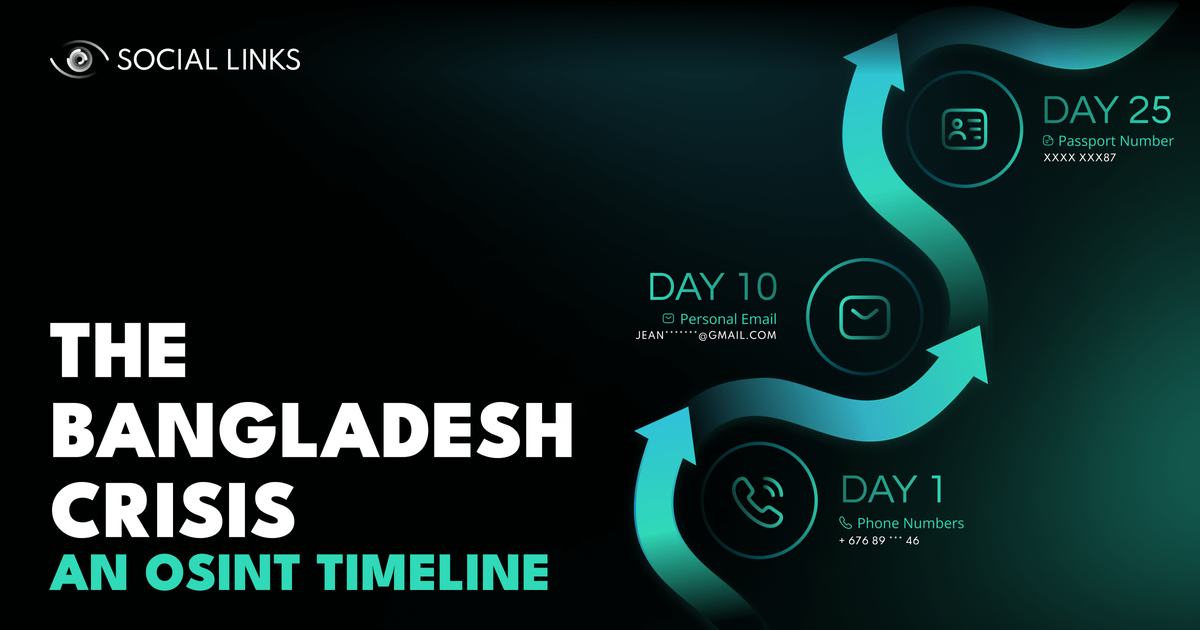The Bangladesh Crisis: An OSINT Timeline


In July 2024, protests broke out in Bangladesh in response to a controversial government job quota system, which allocated one third of government jobs to descendants of veterans from the 1971 Bangladesh Liberation War. As the government responded with a crackdown on demonstrators, the protests escalated into widespread unrest, and within weeks, nearly 300 people were reported dead.
On July 21, the Supreme Court revised the quota system, reducing the allocation. However, statements made by Prime Minister Sheikh Hasina, combined with actions by the police and groups affiliated with the ruling party, added fuel to the fire, leading to a spiralling expansion of the protests. After the death of around 100 people in a police operation on August 4, Prime Minister Hasina was forced to resign and flee the country, marking the end of her 15-year tenure.
Breaking down the timeline of these troubling events, the Social Links Center of Excellence considers how OSINT solutions, such as SL Crimewall, could’ve aided effective responses at each stage of the crisis, avoiding many of the tragic repercussions and maintaining public safety.
Day 1. July 1. Student protests kick off with demands that the job quota is scrapped
When significant social disturbances begin to unfold, social media is a crucial resource for monitoring how the outbreak is progressing, and collecting extensive data on the situation. By conducting keyword and key phrase searches, it’s possible to flag up where gatherings are being organized, and identify the communities involved in creating these ‘hotspots’.
Day 10. July 10. Protests gain momentum
As unrest starts to gain traction and draw in more and more people, having a geographical understanding of what is happening where is absolutely crucial for informing effective countermeasures. Using GPS coordinates to extract posts, photos, and videos in real time and from within a given radius, you can map situations to a high degree of detail and orchestrate responses accordingly.
Days 15–20. July 15–20. The protests escalate into violence following the involvement of the Bangladesh Chhatra League—the student wing of the ruling party
When unrest spirals into violence, it’s crucial not to treat everyone as hooligans—such reactions can lead to very dangerous escalation. Instead, responses need to acquire a level of precision, with investigators looking into specific trouble-makers who are primarily responsible for the violence. Facial recognition tools allow you to home in on the most harmful actors to carry out precise countermeasures.
What’s more, using a wide array of SOCMINT tools, you can identify the network structures underpinning the key groups, including the different members, and how everything fits together.
Day 25. July 25. Protesters redouble demands, now insisting that protest leaders are released, the curfew lifted, and universities reopened
As the situation evolves, so do the issues at stake. Understanding and mapping demographic opinion around the most important talking points can inform policies that will help quell the unrest peacefully. Sentiment analysis features allow such work to be conducted accurately and quickly so that suitable responses can be rolled out promptly.
Day 36. August 5. Prime Minister Hasina resigns and flees the country
While the protest and their attendant risks seem to have wound down, there may still be plenty of volatility bubbling beneath the surface. Monitoring features allow you to keep tabs on opinion leaders and ensure you’re notified if inflammatory rhetoric and the organization of disruptive events begin to reemerge.
Uprisings tend to resemble each other in the way they evolve. There is a distinctive cycle and pattern to events, and OSINT tools such as SL Crimewall empower governments with the ability to respond effectively and appropriately at every stage. Response strategies can be broadly broken down into four areas:
We live in turbulent times, where protests and civil unrest are present and real possibilities for a number of societies. By harnessing the remarkable utility of SL Crimewall, governmental bodies can act in an informed and suitable manner, deploying effective crisis response and—crucially—saving lives. With the judicious application of OSINT tools and techniques, tragedies such as those that we’ve just seen play out in Bangladesh, can not only be mitigated, but averted altogether.
Want to learn more about how OSINT can be a game-changer for crisis response work? Follow the link below to set up a chat with one of our specialists and see how Crimewall could transform a range of processes in your organization, helping you gain better results faster.